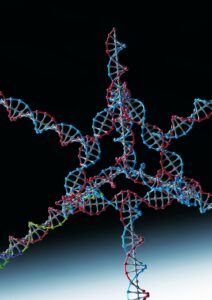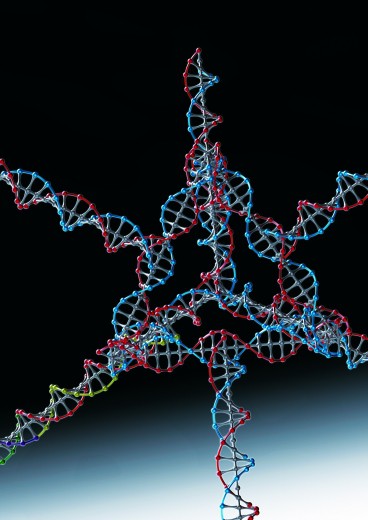
The phenomenon of RNA interference offers one of the most promising therapeutic options of the past decade. Small interfering RNA molecules (siRNAs) specifically decrease the expression of a targeted gene by binding to and destroying the messenger RNA produced by that gene. Delivering these siRNAs to where they are needed is, however, a major challenge. Various types of nanoparticles have shown some success, but a new atomically precise nanoparticle made from DNA and RNA offers better targeting and fewer side effects. A hat tip to KurzweilAI for reprinting this MIT news release “Researchers achieve RNA interference, in a lighter package“:
Using a technique known as “nucleic acid origami,” chemical engineers have built tiny particles made out of DNA and RNA that can deliver snippets of RNA directly to tumors, turning off genes expressed in cancer cells.
To achieve this type of gene shutdown, known as RNA interference, many researchers have tried — with some success — to deliver RNA with particles made from polymers or lipids. However, those materials can pose safety risks and are difficult to target, says Daniel Anderson, an associate professor of health sciences and technology and chemical engineering, and a member of the David H. Koch Institute for Integrative Cancer Research at MIT.
The new particles, developed by researchers at MIT, Alnylam Pharmaceuticals and Harvard Medical School, appear to overcome those challenges, Anderson says. Because the particles are made of DNA and RNA, they are biodegradable and pose no threat to the body. They can also be tagged with molecules of folate (vitamin B9) to target the abundance of folate receptors found on some tumors, including those associated with ovarian cancer — one of the deadliest, hardest-to-treat cancers.
Anderson is senior author of a paper on the particles appearing in the June 3 issue of Nature Nanotechnology [abstract]. Lead author of the paper is former MIT postdoc Hyukjin Lee, now an assistant professor at Ewha Womans University in Seoul, South Korea. …
siRNA-delivering nanoparticles made of lipids, which Anderson’s lab and Alnylam are also developing, have shown some success in turning off cancer genes in animal studies, and clinical trials are now underway in patients with liver cancer. Nanoparticles tend to accumulate in the liver, spleen and lungs, so liver cancer is a natural target — but it has been difficult to target such particles to tumors in other organs.
“When you think of metastatic cancer, you don’t want to just stop in the liver,” Anderson says. “You also want to get to more diverse sites.”
Another obstacle to fulfilling the promise of RNAi has been finding ways to deliver the short strands of RNA without harming healthy tissues in the body. To avoid those possible side effects, Anderson and his colleagues decided to try delivering RNA in a simple package made of DNA. Using nucleic acid origami — which allows researchers to construct 3-D shapes from short segments of DNA — they fused six strands of DNA to create a tetrahedron (a six-edged, four-faced pyramid). A single RNA strand was then affixed to each edge of the tetrahedron.
“What’s particularly exciting about nucleic acid origami is the fact that you can make molecularly identical particles and define the location of every single atom,” Anderson says. …
In their abstract the authors state that “gene silencing occurs only when the ligands are in the appropriate spatial orientation”. Achieving the correct spatial orientation is difficult to do without covalent attachment to an atomically precise nanoparticle.
—James Lewis, PhD
